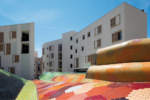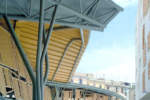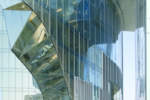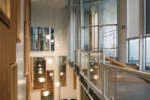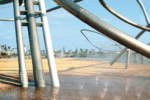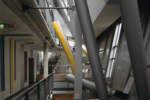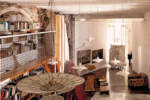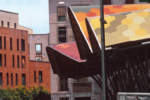To discover and live the “new” market of Santa Caterina in the heart of the old town or Ciutat Vella of Barcelona is like listening to one of those vivacious and curious thoughts that one sometimes speaks out loud in order to animate a stalling debate, to elicit other visions, at the same time asking the help of those around one. The market designed and built by EMBT, i.e. Enric Miralles
+ Benedetta Tagliabue, between 1999 and 2005, is much more than a simple, pretty architecture; rather, it is a smiling question mark, a generous thought for the city and its inhabitants, one of those works that have sought, silently, to ferry our architecture from one period to another. The market and its adjacent urban spaces tell you the story of a traditional Barcelona, about familiar stories, materials and colours, but at the same time about an absolutely contemporary and new way to conceive and build collective places. The story, the stories, regardless of what they are, from the highest and most recognized to those fragments of obscure memory that get stuck inside you, are mixed and digested in the dense body of that system of arches, roofs, metal vaults, wood, ceramic and concrete that embrace the market and the life which incessantly passes through it. This project, like all stories, conceals within it other heroic and dramatic stories which can tell us something more about the recent life and activity of Benedetta Tagliabue, partner and wife of Enric, who remained alone in April 2000, to sustain and manage the great quantity of work and projects produced by EMBT, due to the sudden death of her companion in life and work. The new market is above all a social and civil conquest, to which the two architects have given a crucial contribution in terms of debate and design; the old building was marked for demolition without an adequate public reflection on its future having been developed, and in the firm and indignant reaction of the city, Miralles’ voice was one of the most respected and important ones to recommend a different solution.
After the demolition the traces of the old monastic structure which had occupied this large block came to light; in the meanwhile EMBT, winner of the architecture competition, developed the town plan for the patient and sensible reconstruction of this delicate fragment of the old town. In the same years Enric and Benedetta built their home, a few hundred meters from Santa Caterina, in the heart of the Gothic and working-class city, and it appears difficult to separate these two aspects, public and private project, so much does the experimental and curious dimension prevail in every character, detail and space which is developed and realized. The works are open tales that are waiting for continuous dialogue and use. It is very hard, in every work by EMBT, to identify a conclusive point, but this is not a symptom of uncertainty or inability to complete a work, but rather a strenuous desire to consider the work of architecture as a score that must be interpreted and lived actively, without the architect having necessarily to have the last word. In this attitude we recognize the inquisitive lesson of the Smithsons, Giancarlo De Carlo and the Team X, which the young Miralles assimilated during his summer seminaries and, above all, in the continuous dialogue over time with the couple (another!) of English masters.
But at the same time I believe we must recognize, in the poetic of the open work, the perceptiveness, unresolved and defiant, of an author who no longer seems satisfied with a continuity with local traditions (from Gaudì via Catalan modernism to the contemporary threshold of his local Masters Pinon and Viaplana), or the inquisitive lesson of the Masters of Modernism (Miralles’ university lectures on Le Corbusier were incomparable and acute), but who is seeking a feasible path out from the century which was coming to an end, opening new fronts of research and comparison.
The building site of their home, and the project of Santa Caterina proceeded apace in this period, as well as the first developments for the new Parliament of Scotland in Edinburgh, the university campus of Vigo, the new headquarters for Gas Natural in Barcelona, the expansion of the IUAV in Venice (one of the many poor figures cut and lost opportunities accumulated over the years by our country) in addition to the completion of the building site for a Music School in Hamburg and the Municipality of Utrecht.
This two-year period at the turn of the century has been decisive and dramatically strategic for EMBT, because the firm was slowly making the transition from a small, precious semi-crafts workshop to the dimension of an important internationally recognized firm with more and more demanding and important assignments. And in the heart of this delicate transition it has been deprived of its founding spirit, the acclaimed author, perhaps one of the most limpid and audacious talents the new European architectural culture could boast at that moment.
And Benedetta immediately made a clear and anything but foregone decision, coherent with her background and the philosophy of life that had animated her work with Enric: to continue the projects, naturally, but to avoid the dangerous risk of those who freeze a moment, a style in order to keep alive the fragile sensation of eternity assured by the built work. The works on the tables in those days, and those which have kept arriving in the following years, have been developed by reinforcing the intuition that a work of architecture is the result of a sagacious, strong and silent direction, along with a continuous dialogue with the architects of the firm as well as with the many, and different, fellow travellers who are identified depending on the type of themes that have
to be tackled. The choices made by Benedetta Tagliabue have consisted of a conscious direction of a metamorphosis without a predicate objective, an itinerary where the consolidated characters of the architectural research conducted with Miralles have been enriched and gradually challenged by the opportunities encountered and the sensibilities which would inevitably have surfaced.
And what we find ten years later is the felicitous and problematic result of this metamorphosis which is still ongoing, indicating both new paths and researches which have produced interesting results. In addition to all this, Benedetta Tagliabue is also a figure who has anticipated, with her personal history, a phenomenon that the Italian architectural culture is experiencing in this period, for very different reasons. Lombard by birth, Venetian by university education, when she met and fell in love with Miralles she moved definitively to Barcelona, where she is by now considered a Catalan author by adoption for all effects and purposes, even if I personally like to consider Benedetta as a European architect of a new generation, where linguistic influences and identities are mixed and blurred, resulting in characters that are still awaiting definition. In is today the fate of many young architects of talent who have “had to” leave our country, lacking in opportunities and satisfactions, to open a firm in more advanced urban realities that are more attentive to the quality of contemporary architecture. And when one happens to encounter them one feels that the cultural and symbolic horizon with which they measure swords is Europe, and what it represents in terms of opportunities and characters. I do not believe the future will bring a European Esperanto “style”, but rather a re-elaboration of those urban, semi-urban and collective characters which have made the continental urban system a settlement model in one may still identify models and design reflections for the future. And EMBT continues to work generously along these lines under the smiling and cooperative leadership of Benedetta Tagliabue.
The works of these years demonstrate an ability to listen, in poetic and material terms, to the places that is powerful, able to interpret, especially through an obsessive work on public spaces, the changing and restless dimension of the contemporary society and its emerging desires. The ground floor of the buildings designed by EMBT continue to offer themselves as playgrounds and informal, domestic meeting places between citizens who seek to rebuild free connections and tissues which discreetly rethink the characters of the present-day metropolis.
The long port of Hamburg, like the masterly sequence of public and private spaces for the Parliament of Scotland, but also the fragile and poetic stage machine created for Merce Cunningham, all tell us the story about the same desire and vision, capable of taking different forms and using different materials to adapt to the places it encounters and interprets.
The masonry tissue, that archaic and at the same time modern ability to merge structure and non-structural elements, transforming the wall into an open-air workshop, does not seem to know difference, but only a diversification of intensity between the cemetery wall of Igualada and the brick uprights in Hamburg, those in wood and concrete in Edinburgh, or the transitory and fragile weavings of the Spanish pavilion in Shanghai. It is a complex path which fears no authoritativeness as declaration of poetic research, not as an end in itself, and the expressive charge of the spaces as possible solution for the design of a space for new communities. The tormenting sensation one experiences when seeing the works of the last years, and especially as the “cursed” year of 2000 fades in the distance, is the obstinacy with which Benedetta Tagliabue has sought to design without stopping, without freezing the pain in the forms and in the languages of reference. This, I believe, has been the highest and most loving way to respect the intellectual and creative history of Enric Miralles and, at the same time, to transform it into a free, powerful engine to continue the researches and the paths which also he had contributed to open, in these years of profound and restless metamorphosis.
Miralles – Tagliabue il valore della continuità
area 113
| benedetta tagliabue embt



